

Community portal. Category:Animal intelligence. Christianity myths. Cosmochemistry. Meteorites are often studied as part of cosmochemistry.

Cosmochemistry or chemical cosmology is the study of the chemical composition of matter in the universe and the processes that led to those compositions.[1] This is done primarily through the study of the chemical composition of meteorites and other physical samples. Given that the asteroid parent bodies of meteorites were some of the first solid material to condense from the early solar nebula, cosmochemists are generally, but not exclusively, concerned with the objects contained within the solar system. History[edit] During the 1950s and 1960s, cosmochemistry became more accepted as a science. Coeliac disease. Coeliac disease, also spelled celiac disease, is an autoimmune disorder affecting primarily the small intestine that occurs in people who are genetically predisposed.[1] Classic symptoms include gastrointestinal problems such as chronic diarrhoea, abdominal distention, malabsorption, loss of appetite, and among children failure to grow normally.

This often begins between six months and two years of age.[2] Non-classic symptoms are the most common, especially in people older than two years.[3][4][5] There may be mild or absent gastrointestinal symptoms, a wide number of symptoms involving any part of the body, or no obvious symptoms.[2] Coeliac disease was first described in childhood;[3][6] however, it may develop at any age.[2][3] It is associated with other autoimmune diseases, such as diabetes mellitus type 1 and thyroiditis, among others.[6] Signs and symptoms[edit] Gastrointestinal[edit] Malabsorption-related[edit] Miscellaneous[edit] Cause[edit]
Astrobiology. Astrobiology is the study of the origin, evolution, distribution, and future of life in the universe: extraterrestrial life and life on Earth.

This interdisciplinary field encompasses the search for habitable environments in our Solar System and habitable planets outside our Solar System, the search for evidence of prebiotic chemistry, laboratory and field research into the origins and early evolution of life on Earth, and studies of the potential for life to adapt to challenges on Earth and in outer space.[2] Astrobiology addresses the question of whether life exists beyond Earth, and how humans can detect it if it does.[3] (The term exobiology is similar but more specific — it covers the search for life beyond Earth, and the effects of extraterrestrial environments on living things.)[4] Overview[edit] It is not known whether life elsewhere in the universe would utilize cell structures like those found on Earth.
(Chloroplasts within plant cells shown here.)[19] Astrochemistry. Astrochemistry is the study of the abundance and reactions of chemical elements and molecules in the universe, and their interaction with radiation.
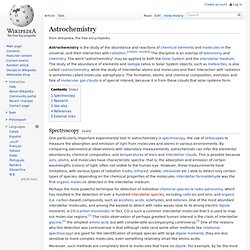
[citation needed] The discipline is an overlap of astronomy and chemistry. The word "astrochemistry" may be applied to both the Solar System and the interstellar medium. University of Cambridge. The University of Cambridge[note 1] (informally known as "Cambridge University" or simply "Cambridge"; abbreviated as "Cantab" in post-nominals[note 2]) is a collegiate public research university in Cambridge, England.

Originally founded in 1209, it is the second-oldest university in the English-speaking world, and the world's third-oldest surviving university.[5] Early records suggest that the university grew out of an association formed by scholars leaving the University of Oxford after a dispute with townsfolk;[6] the two "ancient universities" have many common features and are often jointly referred to as "Oxbridge". The university's endowment (£4.9 billion as of 2013) is the largest of any European university.[17] In the year ended 31 July 2013 the university had a total income of £1.44 billion, of which £332 million was from research grants and contracts.[18] History[edit]
Countries the list of - Search results. Astronomical object. Above the round domes of La Silla Observatory, three astronomical objects in the Solar System — Jupiter (top), Venus (lower left), and Mercury (lower right).[1] Types of Solar System bodies.
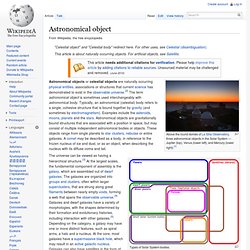
Astronomical objects or celestial objects are naturally occurring physical entities, associations or structures that current science has demonstrated to exist in the observable universe.[2] The term astronomical object is sometimes used interchangeably with astronomical body. Typically, an astronomical (celestial) body refers to a single, cohesive structure that is bound together by gravity (and sometimes by electromagnetism).
Examples include the asteroids, moons, planets and the stars. Astronomical objects are gravitationally bound structures that are associated with a position in space, but may consist of multiple independent astronomical bodies or objects. The constituents of a galaxy are formed out of gaseous matter that assembles through gravitational self-attraction in a hierarchical manner. Astronomy. Astronomy is a natural science that is the study of celestial objects (such as moons, planets, stars, nebulae, and galaxies), the physics, chemistry, and evolution of such objects, and phenomena that originate outside the atmosphere of Earth, including supernovae explosions, gamma ray bursts, and cosmic background radiation.

A related but distinct subject, cosmology, is concerned with studying the universe as a whole.[1] Astronomy is one of the oldest sciences. Prehistoric cultures have left astronomical artifacts such as the Egyptian monuments and Nubian monuments, and early civilizations such as the Babylonians, Greeks, Chinese, Indians, Iranians and Maya performed methodical observations of the night sky. However, the invention of the telescope was required before astronomy was able to develop into a modern science. Astrometry. Illustration of the use of interferometry in the optical wavelength range to determine precise positions of stars.
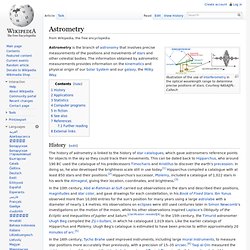
Courtesy NASA/JPL-Caltech Astrometry is the branch of astronomy that involves precise measurements of the positions and movements of stars and other celestial bodies. The information obtained by astrometric measurements provides information on the kinematics and physical origin of our Solar System and our galaxy, the Milky Way. History[edit] Amateur astronomy. Amateur astronomers watch the night sky during the Perseid meteor shower.
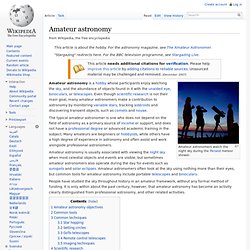
Amateur astronomy is a hobby whose participants enjoy watching the sky, and the abundance of objects found in it with the unaided eye, binoculars, or telescopes. Even though scientific research is not their main goal, many amateur astronomers make a contribution to astronomy by monitoring variable stars, tracking asteroids and discovering transient objects, such as comets and novae. The typical amateur astronomer is one who does not depend on the field of astronomy as a primary source of income or support, and does not have a professional degree or advanced academic training in the subject. Many amateurs are beginners or hobbyists, while others have a high degree of experience in astronomy and often assist and work alongside professional astronomers.
People have studied the sky throughout history in an amateur framework, without any formal method of funding. Asteroid impact avoidance. Artist's impression of a major impact event.
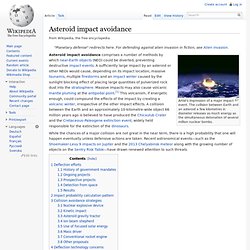
The collision between Earth and an asteroid a few kilometres in diameter releases as much energy as the simultaneous detonation of several million nuclear bombs. Asteroid impact avoidance comprises a number of methods by which near-Earth objects (NEO) could be diverted, preventing destructive impact events. A sufficiently large impact by an asteroid or other NEOs would cause, depending on its impact location, massive tsunamis, multiple firestorms and an impact winter caused by the sunlight blocking effect of placing large quantities of pulverized rock dust into the stratosphere.
Massive impacts may also cause volcanic mantle pluming at the antipodal point.[1] This volcanism, if energetic enough, could compound the effects of the impact by creating a volcanic winter, irrespective of the other impact effects. Deflection efforts[edit] Archaeoastronomy. Archaeoastronomy (also spelled archeoastronomy) is the study of how people in the past "have understood the phenomena in the sky, how they used these phenomena and what role the sky played in their cultures.
"[1] Clive Ruggles argues it is misleading to consider archaeoastronomy to be the study of ancient astronomy, as modern astronomy is a scientific discipline, while archaeoastronomy considers symbolically rich cultural interpretations of phenomena in the sky by other cultures.[2][3] It is often twinned with ethnoastronomy, the anthropological study of skywatching in contemporary societies.
Archaeoastronomy is also closely associated with historical astronomy, the use of historical records of heavenly events to answer astronomical problems and the history of astronomy, which uses written records to evaluate past astronomical practice. Archaeoastronomy can be applied to all cultures and all time periods. Astronomical naming conventions. In ancient times, only the Sun and Moon, a few hundred stars and the most easily visible planets had names.
Over the last few hundred years, the number of identified astronomical objects has risen from hundreds to over a billion, and more are discovered every year. Astronomers need to be able to assign systematic designations to unambiguously identify all of these objects, and at the same time give names to the most interesting objects and, where relevant, features of those objects. The International Astronomical Union (IAU) is the body officially recognized by astronomers and other scientists worldwide as the de facto naming authority for astronomical bodies. In response to the need for unambiguous names for astronomical objects, it has created a number of systematic naming systems for bodies of various sorts. Asia. Asia ( i/ˈeɪʒə/ or /ˈeɪʃə/) is the Earth's largest and most populous continent, located primarily in the eastern and northern hemispheres. It covers 8.7% of the Earth's total surface area and comprises 30% of its land area.
With approximately 4.3 billion people, it hosts 60% of the world's current human population. Asia has a high growth rate in the modern era. Astronautics. Astronautics (alternatively cosmonautics), is the theory and practice of navigation beyond the Earth's atmosphere. In other words, it is the science and technology of spaceflight. The term astronautics was coined by analogy with aeronautics. As there is a certain degree of technology overlapping between the two fields, the term aerospace is often used to describe them both. History[edit] The early history of astronautics is theoretical: the fundamental mathematics of space travel was established by Isaac Newton in his 1687 treatise Philosophiae Naturalis Principia Mathematica.[2] Other mathematicians, such as Swiss Leonhard Euler and Italian Joseph Louis Lagrange also made essential contributions in the 18th and 19th centuries.
Buddhism myths. Evolutionary history of life. Category:Autumn holidays. Modern and ancient harvest festivals or holidays considered culturally integral to the Autumn season.For local festivals see the list of local Autumn festivals. Subcategories. Category:Winter holidays. Astrophysics. Latin spelling and pronunciation. Ley line. Ley lines /leɪ laɪnz/ are supposed alignments of numerous places of geographical and historical interest, such as ancient monuments and megaliths, natural ridge-tops and water-fords. List of United States Navy ratings. From left to right: a Special Warfare Operator 1st Class and a Boatswain's Mate 2nd Class.
Ratings should not be confused with rates, which describe the Navy's enlisted pay-grades and ratings. Enlisted sailors are referred to by their rating and pay-grade. For example, if someone's pay-grade is E-5 (Petty Officer 2nd Class) and his rating is Boatswain's Mate, then combining the two—Boatswain's Mate 2nd Class (BM2)—defines both pay-grade and rating in formal address or epistolary salutation. Thus, Boatswain's Mate 2nd Class (BM2) would be his rate.[2] A member that is E-1, E-2, or E-3 that belongs to a general occupational field (airman, constructionman, fireman, hospitalman, or seaman) is considered nonrated. A striker is a nonrated person who is working for promotion towards a specific rating.
Millennials. Terminology[edit] NATO phonetic alphabet. The Most Distant Galaxies Ever Seen. Medicine. Mining for Knowledge Management Nuggets. List of ethnic, regional, and folk dances by origin. Senior citizen. Senior citizen is a common euphemism for an elderly person in both UK and US English, and it implies or means that the person is retired.[1][2][3][4] This in turn usually implies or in fact means that the person is over the retirement age, which varies according to country.
Synonyms include pensioner in UK English and retiree and senior in US English. Some dictionaries describe widespread usage of "senior citizen" for people over the age of 65.[5] "Senior citizen" is replacing the term old-age pensioner traditionally used in UK English.[6] When defined in an official context, senior citizen is often used for legal or policy-related reasons in determining who is eligible for certain benefits available to the age group. NASA @ en.wikipedia.org. Malaysia. Mental Disability and Migration. Monera. How to Set Up Gmail on an iPhone: 21 Steps. Micro-g environment. Ménière's disease. Pearltrees.
The Proceedings of the Ever so Strange. Phoenician language. Planetary science. PGP word list. Planetarium. Policies and guidelines. Portal:Featured portals. Portal:Language. Onomastics. Observational astronomy. Organism. Remarkable Gardens of France. Remote sensing. Scalable Vector Graphics. Search. Space science Outline of. Precipitable water - meteorology. Space warfare. Category:Spring holidays. Category:Summer holidays. Tumblr. Understanding Media and Culture: An Introduction to Mass Communication 1. Universe. Pedagogy.